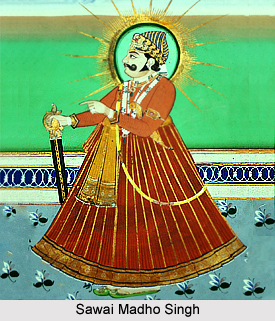 Sawai Madho Singh is one of the well known Rajput rulers who continued his reign over Jaipur for forty two years. He succeeded Sawai Ram Singh II and largely supported the introduction of modernization in Jaipur. This was a phase when Jaipur state and many of the princely states in India were going through the period of modernization and urbanization. A number of reforms were made in the field of administration. Due to some close connections with the British people and other colonial people the native rulers took some aggressive steps to develop their cities and pull them from shackles of traditions. He reorganised postal system, enlarged railways and expanded the building works in the city.
Sawai Madho Singh is one of the well known Rajput rulers who continued his reign over Jaipur for forty two years. He succeeded Sawai Ram Singh II and largely supported the introduction of modernization in Jaipur. This was a phase when Jaipur state and many of the princely states in India were going through the period of modernization and urbanization. A number of reforms were made in the field of administration. Due to some close connections with the British people and other colonial people the native rulers took some aggressive steps to develop their cities and pull them from shackles of traditions. He reorganised postal system, enlarged railways and expanded the building works in the city.
Sawai Madho Singh was personally not very qualified and was a Hindu orthodox. But as he was deeply loyal to the British paramount he decided to travel all the way to England to attend the coronation of King- Emperor Edward VII. He is often known for his celebrated visit to England during which he travelled for days carrying ganga jal along with him in some huge jars made up of Bronze, and the image of Gopalji which went along with him. He was very much liked by the Britishers who gave him a number of honours due to his allegiance towards the British Crown. He was made the honorary LLD of Edinburgh University. Along with his legends he was also known for spending largely. Often Sawai Madho Singh is known for his colossal personality and luxurious lifestyle.
Sawai madho Singh has been well described by one of his faithful kinsmen Amer Singh who describes the life of the Rajput ruler. Among his general habits he spent money wildly, drank excessively and yet left three million rupees. The state revenue increased by four million rupees in a year during his reign. With all his good qualities he was largely taken by superstitions which made him vulnerable to manipulations. As such one of his major concerns was the maintenance of his caste and religion in and outside his state. As he feared that his religion may get hampered he carried the image of Gaopalji all the way to England along with two massive metal jars carrying Gangajal that will help him to maintain his purity even in the foreign land. It was a part of his orthodox beliefs that he restricted himself from having any direct heir either from his own wife or from his official concubines which was advised by the royal jyotishi. As a result he adopted Sawai Man Singh II as his heir apparent who was to succeed him in future. Due to lack of foresighted ness Sawai Madho Singh became a prey to the conspiracy of a man called Bala Bux Khwas who belonged to the tailor caste. It was noted that towards the end of his life maharaja suffered from bad health and the administration of the state was largely left with Bala Bux and his female colleague Roop Rai who was one of the official concubines of the Maharaja. As such the maharaja along with his three wives and eighteen concubines were left on the mercy of Bala Bux who was appointed as one of the nobles of Jaipur court in spite of his menial birth.
Sawai Madho Singh died in 7 September 1922 when he came back to Jaipur from a long trip. He was succeeded by Sawai Man Singh II, the son of Thakur Sawai Singh who was adopted by the Maharaja.



















